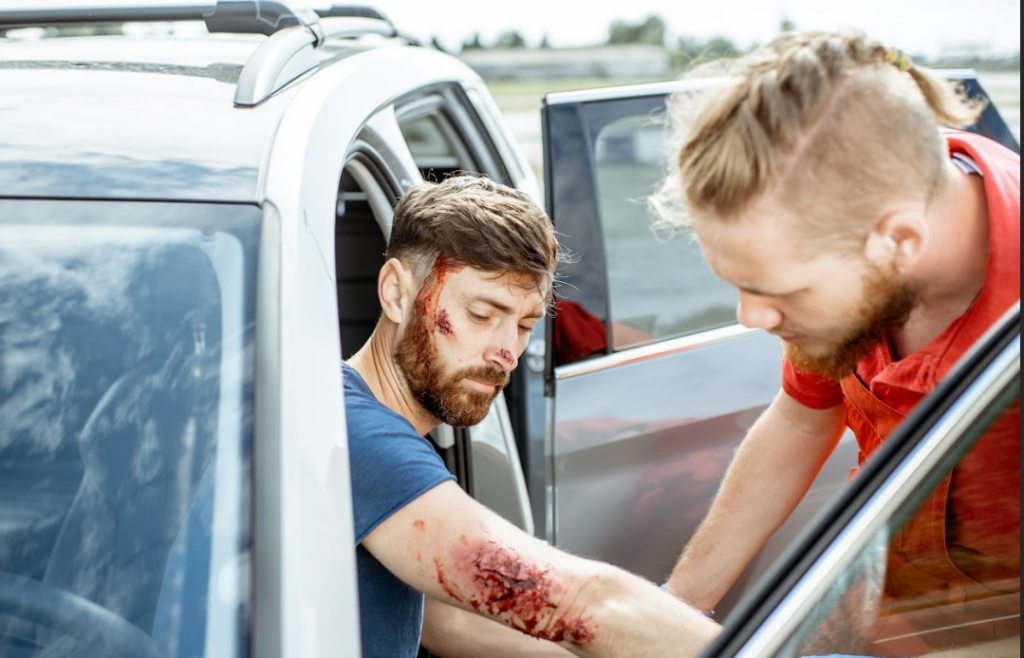
When you see a yellow light in Arizona, it means you should slow down and prepare to stop if it is safe to do so.
If the light turns yellow as you approach an intersection, you should decide if you can safely stop before the red light appears.
If stopping safely isn’t possible, proceed with caution.
Arizona law states that entering an intersection when the light turns red is illegal, even if you initially entered when it was yellow.
Important Points:
- Yellow Light: Caution and prepare to stop.
- Red Light: Must stop before entering the intersection.
Flashing Yellow Light
A flashing yellow light means you should proceed with caution.
It doesn’t require a stop but extra attention is needed because traffic may be crossing or merging.
What To Do When the Light Turns Yellow
- Evaluate Safety: Check if you can stop safely.
- Proceed or Stop: Make a quick decision. Stop if you can do so safely; otherwise, proceed cautiously.
Key Takeaways
- Yellow Light: Slow down and be prepared to stop.
- Flashing Yellow Light: Caution and proceed with more attention.
Types of Collisions at Yellow Lights
At yellow lights, different types of collisions can occur due to drivers’ actions. These include rear-end collisions,
T-bone accidents, and head-on collisions. Each type has unique causes and consequences.
Rear-End Collisions
Rear-end collisions often happen when a driver suddenly stops at a yellow light and the driver behind them doesn’t react in time.
This type of crash is common because many drivers expect the car in front to speed through the yellow light.
Rear-end collisions can cause significant vehicle damage and injuries.
It is essential to maintain a safe following distance and stay alert to avoid these accidents. Whiplash is a common injury from rear-end collisions, resulting from the sudden impact.
Speeding through a yellow light can increase the risk. Higher speeds mean longer stopping distances, making it more challenging to avoid hitting the car in front.
Always be prepared for the vehicle ahead to stop suddenly.
T-Bone Accidents
T-bone accidents occur when a car travels through an intersection on a yellow light and gets hit from the side by another vehicle. These accidents are usually severe because the sides of cars offer less protection than the front or rear.
Drivers speeding through yellow lights increase the chance of T-bone collisions. The impact can cause significant injuries, including fractures and internal injuries.
To avoid T-bone accidents, always check for oncoming traffic before entering an intersection on a yellow light.
Be cautious and consider whether it’s safer to stop rather than risk crossing. Defensive driving can significantly reduce the risk of these serious accidents.
Head-On Collisions
Head-on collisions are less common at yellow lights but can be very dangerous. They usually happen if a driver swerves into oncoming traffic to avoid running a red light. This can occur if a driver tries to beat the light and loses control.
The high impact of head-on collisions can lead to severe injuries or fatalities. Head, neck, and chest injuries are common due to the high force involved.
Speeding through a yellow light increases the chance of losing control and causing a head-on collision.
Always approach intersections with caution and assess the situation. Slowing down and preparing to stop can prevent these dangerous accidents.
Who’s At Fault
When determining responsibility for a yellow light car accident in Arizona, key factors include driver behavior and right-of-way rules.
Evidence like traffic camera footage and police reports can also play a significant role.
Examining Driver Behavior
Driver actions at the time of the accident are crucial.
Was the driver speeding or making an unsafe turn?
Did the driver attempt to beat the light?
Speed, sudden lane changes, and other risky maneuvers may indicate fault.
Police reports usually document these details.
Traffic camera footage can show whether a driver tried to race through the yellow light.
Witness statements also provide valuable insights into how drivers were behaving leading up to the crash.
Understanding Right-of-Way
Arizona law outlines right-of-way rules at intersections.
The driver who legally entered the intersection first generally has the right-of-way.
If a driver fails to yield when required, they may be at fault. Police reports often note who had the right-of-way and if it was violated.
Traffic signals and signs guide right-of-way decisions. Examining these helps determine if a driver ignored marked instructions.
Right-of-way laws are there to prevent accidents and must be respected.

Legal Actions after a Yellow Light Accident
After a yellow light accident in Arizona, you have options for legal actions.
You may file an insurance claim or initiate a lawsuit to seek compensation.
Understanding these steps can aid you in protecting your rights and receiving fair treatment.
Filing an Insurance Claim
If you have been in a yellow light accident, the first action is often filing an insurance claim.
Arizona law follows a fault-based system, meaning the driver at fault is liable for damages.
Steps to Take:
- Contact your insurance company to report the accident.
- Gather evidence such as photos, witness statements, and police reports.
- Seek medical attention immediately, even if injuries seem minor.
- Consult with a car accident lawyer to understand your claim and maximize your settlement.
The statute of limitations in Arizona for filing a claim is two years from the date of the accident. Acting promptly ensures your rights are protected.
Initiating a Lawsuit
If the insurance settlement does not cover your damages, you may need to initiate a lawsuit. This legal process requires proving the other driver’s fault and demonstrating your losses.
Steps to Take:
- Contact an Arizona car accident lawyer to evaluate your case.
- File the lawsuit within two years, per Arizona’s statute of limitations.
- Prepare evidence such as medical records, repair bills, and accident scene details.
- Attend court hearings where your lawyer will present your case.
A lawsuit can lead to a higher settlement, covering medical bills, lost wages, and other damages.
Damages and Compensation
When involved in a yellow light car accident in Arizona, you can seek various types of compensation to cover your losses.
These types include both economic and non-economic damages.
Calculating Economic Damages
Economic damages cover the actual financial losses you incur due to the accident.
Medical bills for hospital stays, surgeries, and follow-up appointments are often the most significant costs.
Repair costs for vehicle damage are included as well.
Lost wages from missed work days are taken into account, as are any potential future earnings lost due to injury.
Receipts and invoices are crucial for proving these damages.
Non-Economic and Punitive Damages
Non-economic damages compensate for pain and suffering, emotional distress, and loss of enjoyment in life.
These are more subjective and are harder to quantify. Punitive damages might come into play if the other party’s actions were especially reckless or malicious.
These are meant to punish the wrongdoer and deter similar behavior.
In Arizona, punitive damages are not capped, which means there’s no legal limit on the amount you can receive.

Insurance Claim Process
Filing an insurance claim after a yellow light car accident in Arizona involves dealing with insurance adjusters and understanding your insurance policy terms.
These steps are crucial to ensure you receive the compensation you deserve.
Dealing with Insurance Adjusters
When you file a claim, an insurance adjuster will be assigned to your case.
They will investigate the accident, including damage to your vehicle and any injuries you sustained.
It’s important to provide them with all necessary documentation such as police reports, medical records, and photos of the accident scene.
Stay calm and clear when talking to the adjuster.
They might try to offer a settlement quickly for less than your claim is worth.
It’s okay to negotiate or to seek legal advice before accepting any offer. Remember, adjusters work for the insurance company, so their goal may be to minimize the payout.
Understanding Insurance Policy Terms
Reviewing your insurance policy can help you understand what types of coverage you have. Key terms to look for include:
- Liability Coverage: Pays for damages you cause to others.
- Collision Coverage: Covers damage to your own vehicle from the accident.
- Medical Payments Coverage: Helps with medical expenses after the accident.
- Uninsured/Underinsured Motorist Coverage: Protects you if the other driver lacks sufficient insurance.
Know the limits and deductibles associated with each type of coverage.
This will help you set realistic expectations for your claim. If you have questions, don’t hesitate to consult your insurance agent for clarification.
Gathering Evidence for Your Claim
To show who is at fault in a yellow light car accident in Arizona, you need solid evidence.
This might include traffic camera footage and witness statements.
Obtaining Traffic Camera Footage
Traffic cameras can provide clear evidence of what happened during the accident. You can request footage from the city or state traffic departments.
The footage can show if the other driver ran a red light or if you had the right of way.
When requesting footage, be specific about the date, time, and location of the accident. This will help the authorities find the right video.
Sometimes, you may need an attorney to make this request, but it is worth it.
Collecting Witness Statements
Witnesses can offer valuable information about the accident. Right after the accident, try to get names and contact details of anyone who saw what happened.
Witnesses might provide details that cameras can’t catch, like driver behavior or conditions at the scene.
Ask the witnesses to write a statement about what they saw.
Be sure to include their observations and any details they remember.
These statements can be very useful when filing an insurance claim or if you need to go to court.
Why Hire a Lawyer
When you’re involved in a yellow light car accident in Arizona, legal representation can be crucial.
Lawyers can help gather evidence, such as traffic camera footage, witness statements, and police reports. This information can strengthen your case.
Negotiation is another key role of legal representation.
Phoenix Car accident lawyers can negotiate with insurance companies to ensure you get a fair settlement.
They aim to maximize compensation for medical bills, vehicle repairs, and other damages.
If the case goes to court, a lawyer provides guidance and support through the legal process.
They handle the paperwork, filings, and court appearances so you don’t have to.
Hiring an Arizona car accident lawyer can also help you understand state-specific laws.
Arizona has particular rules that could impact your claim, and a local lawyer will know these intricacies.
Benefits of Hiring a Lawyer:
- Expert negotiation with insurance companies
- Collection and analysis of evidence
- Court representation if necessary
- Understanding state-specific laws
If you have been in a yellow light car accident in Arizona, consider contacting an Arizona car accident lawyer.
Legal expertise can make a big difference in your claim and help you get the maximum settlement you deserve.
Impact of Accident on Personal Life
A car accident can change many parts of your life. It can affect your body and mind, making daily activities hard to handle.
Physical Recovery Process
After a car accident, you may face physical injuries. Broken bones, bruises, or whiplash are common.
Recovery can take weeks or months. You might need physical therapy daily.
Regular doctor visits become part of your routine.
Pain and discomfort can make working or even walking difficult.
Medications may be needed to manage pain. These medications can have side effects. Adjusting to these new routines can cause stress.
It’s important to follow medical advice closely to heal properly.
Emotional and Psychological Effects
An accident can also hurt your mind. You might feel scared or anxious about driving again.
This anxiety can lead to avoiding daily commutes or even feeling nervous as a passenger.
Depression and post-traumatic stress disorder (PTSD) can also develop after such an event.
You might experience bad dreams or flashbacks. Counseling or therapy can often help manage these feelings.
Talking to a mental health professional is crucial.
They can provide tools and strategies to cope. Emotional healing takes time and support.





